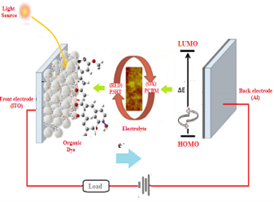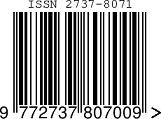A Comprehensive Study on Utility of Carrier Transportation Layer for Efficiency Improvement of Organic Photovoltaic Devices using GPVDM Modeling
Keywords:
Organic device, series resistance, trap energy, ideality factor, device efficiencyAbstract
A comparative study on the electrical parameters of organic photovoltaic device has been taken into consideration for unified realization about the need of carrier transportation layer in organic photovoltaic devices. The parameters have been measured by modeling the devices using simulation technique. Device efficiency of transportation layer P3HT:PCBM incorporated device has been obtained increasing comparatively. Possible reason of such improvement in device efficiency has been demonstrated on the basis of theoretical point of view. Series resistance and ideality factor has been estimated from IdV/dI-I plot. About three times reduction of the following has been encountered with addition of P3HT:PCBM compound. Such significant reduction of series resistance (Rs) and trap energy (Et) are found to be responsible for the probable reason of improvement of device efficiency which are calculated by analyzing Current-Voltage (I-V) characteristics. Differential technique of current voltage relationship has also been implemented to explain the trapping distribution for both devices. It has been found that trap factor increases for P3HT:PCBM compound device comparatively which concludes better conduction into the device.
Downloads
References
Brabec. C J, Sariciftci. N S, Hummelen. J C, (2001) Plastic solar cells Adv. Funct. Mater. 11: 15-26. https://doi.org/10.1002/1616-3028(200102)
Yu. G, Heeger. A J,(1995) Charge separation and photovoltaic conversion in polymer composites with internal donor/acceptor heterojunctions, J Appl Phys. 78: 4510–4515. http://doi:10.1063/1.359792
Shah. M, Sayyad. M H, Karimov. Kh S and Tahir. M, (2010) Investigation of the electrical properties of a surface-type Al/NiPc/Ag Schottky diode using I–V and C–V characteristics, Physica B 405: 1188–92. https://doi.org/10.1016/j.physb.2009.11.034
Chakraborty. S, Manik. N B, (2016) Effect of single walled carbon nanotubes on the threshold voltage of dye based photovoltaic devices, Physica B. 481: 209-216. http://dx.doi.org/10.1016/j.physb.2015.11.005
MacKenzie. R, Kirchartz. T, Dibb. G, and Nelson. J, (2011) Modeling Nongeminate Recombination in P3HT:PCBM Solar Cells, J. Phys. Chem. C, 115 (19): 9806-9813. https://doi.org/10.1021/jp200234m
Sims. L, Hörmann. U, Hanfland. R, MacKenzie. R, Kogler. F, Steim. R, Brütting. W, Schilinsky. P, (2014) Investigation of the s-shape caused by the hole selective layer in bulk heterojunction solar cells, Org Elect. 15: 2862-2867. https://doi.org/10.1016/j.orgel.2014.08.010
Chakraborty. K, Malakar. S, Mandal. D K, Mondal. R, Maiti. A K, (2019) Experimental Prediction of Effect of Thickness of Active Layer of Photovoltaic Device on a series of Electrical Parameters using GPVDM Software Int J Adv. Sci Eng. 6: 42-46. https://doi.org/10.29294/IJASE.6.S1.2019.42-46
Rakhshani. A E, (2001) Heterojunction properties of electrodeposited CdTe/CdS solar cells, J App Phys, 90 (8): 4265-4271. http://dx.doi.org/10.1063/1.1397279
Shen. Y, Li. K, Majumdar. N, Campbell. J C, Gupta. M C, (2011) Bulk and contact resistance in P3HT:PCBM heterojunction solar cells, Sol Mat. Sol Cell, 95: 2314-2317. http:// doi:10.1016/j.solmat.2011.03.046
Chakraborty. K, Chakraborty. S, Manik. N B, (2018) Effect of single walled carbon nanotubes on series resistance of Rose Bengal and Methyl Red dye-based organic photovoltaic device J Semiconduct. 39: 094001 1-7. 7 http:// doi: 10.1088/1674-4926/39/9/094001
Scher. H, Montroll. E W, (1975) Anomalous transit-time dispersion in amorphous solids, Phys Rev B, 12(6): 2455–2477.
Rizvi. S, Mantri. P, Mazhari. B, (2014) Traps signature in steady state current-voltage characteristics of organic diode, J. App. Phys. 115: 244502-1. http://dx.doi.org/10.1063/1.4884838
Rizvi. S, Mazhari. B, (2018) Investigation of Traps in Thin-Film Organic Semiconductors Using Differential Analysis of Steady-State Current–Voltage Characteristics, IEEE Trans Elect. Dev. 65(8) : 3430-3437. http:// doi: 10.1109/TED.2018.2849346
Shah. M, Sayyad. M H, Karimov. K, (2011) Electrical characterization of the organic semiconductor Ag/CuPc/Au diode, Journal of Semiconductors, 32: 4. http://doi: 10.1088/1674-4926/32/4/044001
Mantri. P, Rizvi. S, Mazhari. B, (2013) Estimation of built-in voltage from steady-state current-voltage characteristics of organic diodes, Org. Elect, 14(3): 2034-2038. https://doi.org/10.1016/j.orgel.2013.04.030
Deschler. F, Riede. D, Ecker. B, Como. E D, Hauff. E, MacKenzie. R, (2013) Increasing organic solar cell efficiency with polymer interlayers, P Chm Chm P., 15(3): 764-769. http://doi: 10.1039/c2cp43876c
Chakraborty. S, Halder. A, Manik. N B, (2014) Size Effect of Multi-walled Carbon Nanotubes on the Performance of Malachite Green Dye Based Photovoltaic Devices, J. Basic App Engg Res. 1(4): 85-89. 18. Wetzelaer. G J, Blom. P WM, (2014) Diffusion-driven currents in organic semiconductor diodes, N. Asia. Mat., 6: 1-13. http://doi: 10.1038/am.2014.41
Kim. C H, Yaghmazadeh. O, Bonnassieux. Y, Horowitz. G, (2011) Modeling the low-voltage of organic diodes: Origin of the ideality factor 110 : 093722(1-8). http:// doi: 10.1063/1.3660221
Fan. X, Nie. W, Tsai. H, Wang. N, Huang H et al. (2019) PEDOT:PSS for Flexible and Stretchable Electronics: Modifications, Strategies, and Applications: Adv. Sci. News., 6 : 1900813 (1-41). https://doi.org/10.1002/advs.201900813
Greiner. M T, Helander. M G, Tang. W M, Wang. Z. B, Qiu. J, Lu. Z H, (2017) Universal energy-level alignment of molecules on metal oxides: Nature. Mat., 11 : 76-81. https://doi.org/10.1038/nmat3159
Ullah. N, Shah. S M, Hussain. H, Ansir. R, Husain. M N, (2020) Pyrocatechol violet sensitized Ho-TiO2/ZnO nanostructured material: as photoanode for dye sensitized solar cells, Mater. Res. Express., 7 : 035003 (1-15). https://doi.org/10.1088/2053-1591/ab7866
Farjamtalab. I, Kashaniniya. A, Nadooshan. R S, (2015) Improving power conversion efficiency in bulk heterojunction P3HT: PCBM organic solar cells by utilizing RGO-TiO2, IOSR-JAP., 7:(41-48). DOI: 10.9790/4861-07514148
Park. M, Chin. B D, Yu. J W, Chun. M S, Han. S H, (2008) Enhanced photocurrent and efficiency of poly (3-hexylthiophene)/ fullerene photovoltaic devices by the incorporation of gold nanoparticles, J. Industrial and Engg. Chem. 14 : 382-386. 10.1016/j.jiec.2008.01.014
Elumalai. N K, Vijila. C, Jose.R, Zie. Z, Ramakrishna. S, (2014) Effect of trap depth and interfacial energy barrier on charge transport in inverted organic solar cells employing nanostructured ZnO as electron buffer layer, J. Nanotech. 11: 322-332. DOI: 10.1504/IJNT.2014.059833
Ratcliff et al. (2011) Challenges and Oppurtunities in Light and Electrical Energy Conversion, 2 : 1351-1352. dx.doi.org/10.1021/jz2005607
Gershon. T, (2011) Metal oxide applications in organic-based photovoltaics, Mat. Sci. Tech., 27 : 1357-1371. DOI: 10.1179/026708311X13081465539809
Groves. C, (2013) Developing understanding of organic photovoltaic devices: KINETIC Monte Carlo models of geminate and non-geminate recombination, charge transport and charge extraction, Energy. Envior. Sci., 6 : 3202-3217. https://doi.org/10.1039/C3EE41621F
Tengstedt. C, (2006) Fermi-level pinning at conjugated polymer interfaces, Appl. Phys.Lett., 88 : 053502. DOI: 10.1063/1.2168515
Wang. Z, Yin. H, Tang. Y, Ren. X, Yuan. H, Yan. N, (2020) Design of TiO2?based nanocomposite via two?step method on Aland Fe?doped Ti3SiC2 ceramic for photo-electrode, SN App.Sc., 2 : 1121
Homepage (detectors and imaging), ORGANIC PHOTOVOLTAICS: Transition metal oxides increase organic solar-cell power conversion, Laser Focus World (webpage)
Almeida. B M, M. Jr. M A, Bettini. J, Beneditti. J E, Nogueira. A F, (2014) A novel nanocomposite based on TiO2/Cu2O/reduced graphene oxide with enhanced solar-light-driven photocatalytic activity, App. Sur. Sc. 324: 419-431. DOI: 10.1016/j.apsusc.2014.10.105
Ismail. Y A M, Soga. T, Jimbo. T, (2009) Improvement in light harvesting and performance of P3HT:PCBM solar cell by using 9,10-diphenylanthracene, Sol. Mat. Sol. Cell. 93: 1582-1586. https://doi.org/10.1016/j.solmat.2009.04.012
Li. F, Zhao. J, Tao. K, Chen. Y, (2012) Origin of the efficiency improvement in pre-annealed P3HT/PCBM solar cells with LiF/Al electrodes, Chem. Phys. Lett. 553: 36-40. https://doi.org/10.1016/j.cplett.2012.10.006
Sen. S, Manik. N B, (2019) Effect of Carboxyl-Functionalized Single Walled Carbon Nanotubes on the Interfacial Barrier Height of Malachite Green Dye Based Organic Device, Phys. Int. 10: 1-6. DOI: 10.3844/jmrsp.2019.1.7
Lee. H Y, Huang. H, (2014) Investigation Performance and Mechanisms of Inverted Polymer Solar Cells by Pentacene Doped P3HT : PCBM, Int. J. Photoenergy., 2014: 1-9. http://dx.doi.org/10.1155/2014/812643

Downloads
Published
How to Cite
Issue
Section
License
Copyright (c) 2022 KUSHAL CHAKRABORTY, Ratan Mandal, Dulal Krishna Mandal

This work is licensed under a Creative Commons Attribution 4.0 International License.
Copyright on any article in the International Journal of Engineering and Applied Physics is retained by the author(s) under the Creative Commons license, which permits unrestricted use, distribution, and reproduction provided the original work is properly cited.
License agreement
Authors grant IJEAP a license to publish the article and identify IJEAP as the original publisher.
Authors also grant any third party the right to use, distribute and reproduce the article in any medium, provided the original work is properly cited.














